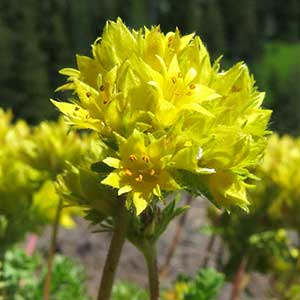Ivesia gordonii
Ivesia rhypara
alpine ivesia, alpine mousetail, Gordon's ivesia
grimy ivesia, grimy mousetail
prostrate to erect, (0.2–)0.5–4 dm.
± prostrate, (0.1–)0.2–1.5(–2) dm.
tightly to loosely cylindric, (1–)3–20(–25) cm; sheathing base ± glandular abaxially, otherwise glabrous;
petiole 0.5–8 cm, hairs 0.2–0.5 mm;
leaflets (6–)10–25 per side, (1–)2–13(–18) mm, glabrous or ± hirsute or villous, glandular-puberulent or -pubescent, lobes (2–)4–8(–15), linear or narrowly oblanceolate to obovate, apex rarely setose.
tightly cylindric, 2–10 cm; sheathing base densely hairy abaxially;
petiole 0.5–4(–10) cm;
lateral leaflets 4–10(–15) per side, overlapping at least distally, ± flabellate, 0.5–3(–4) mm, incised to base or nearly so into (0–)2–4(–9) elliptic to obovate or orbiculate lobes, apex usually not setose, surfaces densely hirsute, cryptically glandular;
terminal leaflets indistinct.
1(–2), not paired.
(0–)1;
blade vestigial.
5–50(–70)-flowered, 1–8(–11) cm diam.;
glomerules 1–several.
5–60(–100)-flowered, congested, 0.5–5(–7) cm diam.
1–3(–5) mm.
1.5–4(–8) mm.
5–12 mm diam.;
epicalyx bractlets linear to narrowly elliptic, (0.5–)1–3.5(–4) mm;
hypanthium turbinate to campanulate, (1.5–)2–4(–4.5) × 2–4(–5) mm;
sepals (2–)2.5–5(–6) mm, obtuse to ± acute;
petals yellow, narrowly oblanceolate to narrowly spatulate, (1–)1.5–3 mm;
stamens 5, filaments 1.3–2.5 mm, anthers yellow, sometimes red-margined, 0.5–1 mm;
carpels (1–)2–4(–6), styles 2.5–4.5(–6) mm.
4–8 mm diam.;
epicalyx bractlets 5, linear to elliptic or narrowly ovate, 0.8–1.6(–2.1) mm;
hypanthium patelliform to shallowly cupulate, 1–1.5 × (1.5–)2–3(–3.5) mm;
sepals 1.4–2.5(–2.8) mm, acute;
petals white to pale yellowish, linear to narrowly oblanceolate, 1–1.5 mm;
stamens 5, filaments 0.6–1.8 mm, anthers maroon or yellow with maroon margins, oblong, 0.3–0.6 mm;
carpels 1–2(–4), styles 1–1.5 mm.
grayish brown to mottled brown, ± 2 mm.
brown, 1.2–1.6(–2) mm, smooth, prominently carunculate.
Ivesia gordonii
Ivesia rhypara
Varieties 4 (4 in the flora).
Ivesia gordonii is the most widespread species of the genus, occurring from Washington to Montana, south to central California and Colorado. The species can be distinguished from other members of sect. Ivesia by the relatively deep hypanthium, which is about as deep as wide. Four varieties are provisionally recognized here (B. Ertter and J. L. Reveal 2007), with the likelihood that future work may indicate additional and/or alternate circumscriptions. Populations that are difficult to assign to a variety can be found where the recognizable taxonomic units come together, for example, in northeastern Utah and western Wyoming, involving var. gordonii and var. wasatchensis, and in California and central Idaho where var. alpicola and var. ursinorum tend to merge.
(Discussion copyrighted by Flora of North America; reprinted with permission.)
Varieties 2 (2 in the flora).
Ivesia rhypara forms densely hairy mats or mounds on isolated edaphic sites in the northern Great Basin. Only one of the widely disjunct population clusters is recognized as a distinct variety; the others have general differences in gestalt, but no significant distinctions have been determined (B. Ertter 1989). Isozyme analysis likewise does not show significant differences (T. Kaye et al., unpubl., BLM and Oregon Dept. of Agriculture, 1991). Reproductive studies by D. Wiens (pers. comm.) show low seed set (ca. 5% in var. rhypara, somewhat higher in var. shellyi), possibly indicating a deleterious genetic load.
(Discussion copyrighted by Flora of North America; reprinted with permission.)
1. Leaflets 7–13(–18) mm, glabrous or sparsely hirsute or villous marginally; stems (1–)1.5–4 dm; inflorescences usually branched, 2–8(–11) cm diam., glomerules (1–)2–6(–10), ± capitate. | var. wasatchensis |
1. Leaflets (1–)2–7(–9) mm, hairy or ± glabrous except marginally ciliate; stems (0.2–)0.5–2.5 dm; inflorescences simple or branched, 1–3(–5) cm diam., glomerules 1(–3), ± capitate to loosely congested | → 2 |
2. Stems usually prostrate to ascending, rarely nearly erect, usually dark reddish, minutely glandular or glandular-puberulent to -pubescent; leaves to 0.8 cm diam.; anthers usually red-margined. | var. ursinorum |
2. Stems usually ascending to erect, sometimes decumbent, usually greenish, rarely reddish, hirsute to villous, glandular-puberulent to -pubescent; leaves to 1.5 cm diam.; anthers rarely red-margined | → 3 |
3. Stems usually hirsute to villous, sometimes densely so, glandular-pubescent or eglandular; basal leaves (3–)5–10(–15) cm; flowers 7–12 mm diam.; e Idaho and w Montana to Utah, Wyoming, and w Colorado. | var. gordonii |
3. Stems not or sparsely hirsute to villous, glandular-puberulent or -pubescent; basal leaves 2–8(–10) cm; flowers 5–9 mm diam.; s Washington to California and e to w Montana. | var. alpicola |
1. Plants (4–)8–30 cm diam.; inflorescences (1–)2–5(–7) cm diam.; scarcely or cryptically petrophytic in bedrock overlain by rubble and soil. | var. rhypara |
1. Plants 2–10(–15) cm diam.; inflorescences 0.5–2(–5) cm diam.; overtly petrophytic in boulders and outcrops. | var. shellyi |


